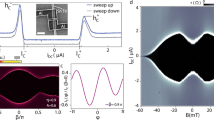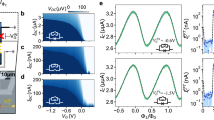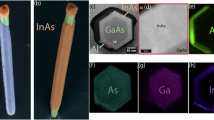Abstract
Gate-tunable semiconductor nanowires with superconducting leads have great potential for quantum computation1,2,3 and as model systems for mesoscopic Josephson junctions4,5. The supercurrent, I, versus the phase, φ, across the junction is called the current–phase relation (CPR). It can reveal not only the amplitude of the critical current, but also the number of modes and their transmission. We measured the CPR of many individual InAs nanowire Josephson junctions, one junction at a time. Both the amplitude and shape of the CPR varied between junctions, with small critical currents and skewed CPRs indicating few-mode junctions with high transmissions. In a gate-tunable junction, we found that the CPR varied with gate voltage: near the onset of supercurrent, we observed behaviour consistent with resonant tunnelling through a single, highly transmitting mode. The gate dependence is consistent with modelled subband structure that includes an effective tunnelling barrier due to an abrupt change in the Fermi level at the boundary of the gate-tuned region. These measurements of skewed, tunable, few-mode CPRs are promising both for applications that require anharmonic junctions6,7 and for Majorana readout proposals8.
This is a preview of subscription content, access via your institution
Access options
Access Nature and 54 other Nature Portfolio journals
Get Nature+, our best-value online-access subscription
$32.99 / 30 days
cancel any time
Subscribe to this journal
Receive 12 print issues and online access
$259.00 per year
only $21.58 per issue
Buy this article
- Purchase on SpringerLink
- Instant access to full article PDF
Prices may be subject to local taxes which are calculated during checkout





Similar content being viewed by others
References
Mourik, V. et al. Signatures of Majorana fermions in hybrid superconductor-semiconductor nanowire devices. Science 336, 1003–1007 (2012).
Chang, W. et al. Hard gap in epitaxial semiconductor–superconductor nanowires. Nat. Nanotech. 10, 232–236 (2015).
Albrecht, S. M. et al. Exponential protection of zero modes in Majorana islands. Nature 531, 206–209 (2016).
Beenakker, C. W. J. Transport Phenomena in Mesoscopic Systems 235–253 (Springer, 1992).
Furusaki, A., Takayanagi, H. & Tsukada, M. Josephson effect of the superconducting quantum point contact. Phys. Rev. B 45, 10563–10575 (1992).
Larsen, T. W. et al. Semiconductor-nanowire-based superconducting qubit. Phys. Rev. Lett. 115, 127001 (2015).
de Lange, G. et al. Realization of microwave quantum circuits using hybrid superconducting-semiconducting nanowire Josephson elements. Phys. Rev. Lett. 115, 127002 (2015).
Hyart, T. et al. Flux-controlled quantum computation with Majorana fermions. Phys. Rev. B 88, 035121 (2013).
Doh, Y.-J. et al. Tunable supercurrent through semiconductor nanowires. Science 309, 272–275 (2005).
Günel, H. Y. et al. Supercurrent in Nb/InAs-nanowire/Nb Josephson junctions. J. Appl. Phys. 112, 034316 (2012).
Abay, S. et al. Quantized conductance and its correlation to the supercurrent in a nanowire connected to superconductors. Nano Lett. 13, 3614–3617 (2013).
Nilsson, H. A., Samuelsson, P., Caroff, P. & Xu, H. Q. Supercurrent and multiple Andreev reflections in an InSb nanowire Josephson junction. Nano Lett. 12, 228–233 (2011).
Li, S. et al. Coherent charge transport in ballistic InSb nanowire Josephson junctions. Sci. Rep. 6, 24822 (2016).
Jackel, L. D., Webb, W. W., Lukens, J. E. & Pei, S. S. Measurement of the probability distribution of thermally excited fluxoid quantum transitions in a superconducting ring closed by a Josephson junction. Phys. Rev. B 9, 115–118 (1974).
Sochnikov, I. et al. Direct measurement of current-phase relations in superconductor/topological insulator/superconductor junctions. Nano Lett. 13, 3086–3092 (2013).
Sochnikov, I. et al. Nonsinusoidal current-phase relationship in Josephson junctions from the 3d topological insulator HgTe. Phys. Rev. Lett. 114, 066801 (2015).
Krogstrup, P. et al. Epitaxy of semiconductor–superconductor nanowires. Nat. Mater. 14, 400–406 (2015).
Golubov, A. A., Kupriyanov, M. Yu. & Il’Ichev, E. The current-phase relation in Josephson junctions. Rev. Mod. Phys. 76, 411–469 (2004).
Scheer, E., Joyez, P., Esteve, D., Urbina, C. & Devoret, M. H. Conduction channel transmissions of atomic-size aluminum contacts. Phys. Rev. Lett. 78, 3535–3538 (1997).
Della Rocca, M. L. et al. Measurement of the current-phase relation of superconducting atomic contacts. Phys. Rev. Lett. 99, 127005 (2007).
English, C. D. et al. Observation of nonsinusoidal current-phase relation in graphene Josephson junctions. Phys. Rev. B 94, 115435 (2016).
Groth, C. W., Wimmer, M., Akhmerov, A. R. & Waintal, X. Kwant: a software package for quantum transport. New J. Phys. 16, 063065 (2014).
Dell’Anna, L., Zazunov, A., Egger, R. & Martin, T. Josephson current through a quantum dot with spin-orbit coupling. Phys. Rev. B 75, 085305 (2007).
Vecino, E., Martín-Rodero, A. & Levy Yeyati, A. Josephson current through a correlated quantum level: Andreev states and π junction behavior. Phys. Rev. B 68, 035105 (2003).
Lee, E. J. H. et al. Spin-resolved Andreev levels and parity crossings in hybrid superconductor-semiconductor nanostructures. Nat. Nanotech. 9, 79–84 (2014).
Hart, S. et al. Induced superconductivity in the quantum spin Hall edge. Nat. Phys. 10, 638–643 (2014).
Allen, M. T. et al. Spatially resolved edge currents and guided-wave electronic states in graphene. Nat. Phys. 12, 128–133 (2016).
Alicea, J., Oreg, Y., Refael, G., von Oppen, F. & Fisher, M. P. A. Non-Abelian statistics and topological quantum information processing in 1D wire networks. Nat. Phys. 7, 412–417 (2011).
Fu, L. & Kane, C. L. Josephson current and noise at a superconductor/quantum-spin-Hall-insulator/superconductor junction. Phys. Rev. B 79, 161408 (2009).
Gardner, B. W. et al. Scanning superconducting quantum interference device susceptometry. Rev. Sci. Instrum. 72, 2361–2364 (2001).
Huber, M. E. et al. Gradiometric micro-SQUID susceptometer for scanning measurements of mesoscopic samples. Rev. Sci. Instrum. 79, 053704 (2008).
Brandt, E. H. Thin superconductors and SQUIDs in perpendicular magnetic field. Phys. Rev. B 72, 024529 (2005).
Acknowledgements
We thank S. Hart, J. Kirtley and C. Beenakker for useful discussions and C. Watson, Z. Cui and I. Sochnikov for useful discussions and experimental assistance. The scanning SQUID measurements were supported by the Department of Energy, Office of Basic Energy Sciences, Division of Materials Sciences and Engineering, under Contract No. DE-AC02-76SF00515. Nanowire growth and device fabrication was supported by Microsoft Project Q, the Danish National Research Foundation, the Lundbeck Foundation, the Carlsberg Foundation, and the European Commission. C.M.M. acknowledges support from the Villum Foundation.
Author information
Authors and Affiliations
Contributions
P.K. and J.N. developed the nanowire materials, M.D. and S.V. fabricated the devices and E.M.S. performed the scanning SQUID measurements, analysed the data, and performed simulations. E.M.S. and K.A.M. wrote the manuscript with input from all coauthors.
Corresponding author
Ethics declarations
Competing interests
The authors declare no competing financial interests.
Supplementary information
Supplementary information
Supplementary information (PDF 1217 kb)
Rights and permissions
About this article
Cite this article
Spanton, E., Deng, M., Vaitiekėnas, S. et al. Current–phase relations of few-mode InAs nanowire Josephson junctions. Nature Phys 13, 1177–1181 (2017). https://doi.org/10.1038/nphys4224
Received:
Accepted:
Published:
Issue date:
DOI: https://doi.org/10.1038/nphys4224
This article is cited by
-
Gate- and flux-tunable sin(2φ) Josephson element with planar-Ge junctions
Nature Communications (2025)
-
Charge-4e supercurrent in a two-dimensional InAs-Al superconductor-semiconductor heterostructure
Communications Physics (2024)
-
Microwave-induced conductance replicas in hybrid Josephson junctions without Floquet—Andreev states
Nature Communications (2023)
-
Experimental review on Majorana zero-modes in hybrid nanowires
Science China Physics, Mechanics & Astronomy (2021)
-
Highly skewed current–phase relation in superconductor–topological insulator–superconductor Josephson junctions
npj Quantum Materials (2020)



